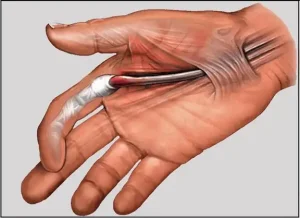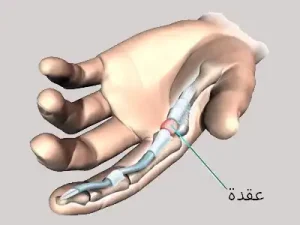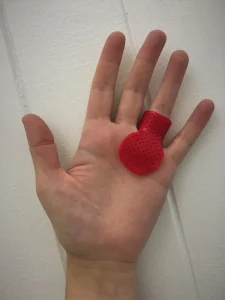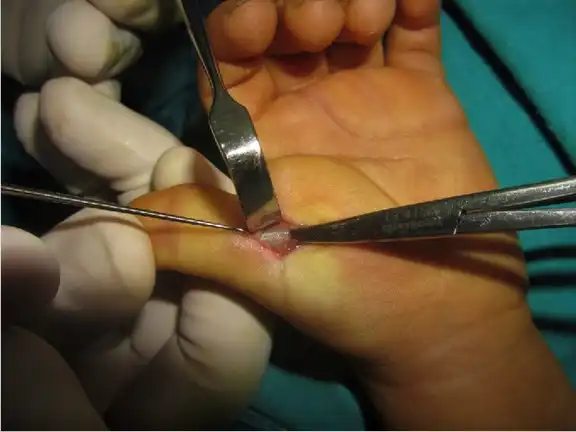الإصبع الزنادية هي حالة تتسبب في تعلق أصابعك أو إبهامك في وضع منحني. أولئك الذين لديهم الإصبع الزنادية قد يكون لديهم تيبس عند ثني الإصبع (الأصابع) أو سماع صوت طقطقة وفرقعة عند تحريك الإصبع (الأصابع). اعتمادًا على شدة الحالة، يمكن أن تتراوح خيارات علاج الإصبع الزنادي في تركيا من الراحة إلى الجراحة.

ما هي ظاهرة الإصبع الزنادية Trigger finger؟
تحدث الإصبع الزنادية عندما تنحشر أصابعك أو إبهامك في وضع منحني – كما لو كان يضغط على “الزناد”. ويمكن أن تحدث الإصبع الزنادية في إصبع واحد أو أكثر.
غالبًا ما يكون إصبع الخاتم أحد الأصابع المتأثرة. تُعرف الحالة أيضًا باسم التهاب غمد الوتر الضيق.
كثيراً ماتشبه هذه الحالة إصبع القدم المطرقية في القدم. كما أن طريقة علاجها قد تتشابه بشكل نسبي.
من يظهر لديه الإصبع الزنادية؟
يشيع ظهور الإصبع الزنادية في:
الأشخاص الذين لديهم وظائف أو هوايات أو مهام تتطلب حركات متكررة مرهقة؛ كالإمساك أو الإمساك المتكرر أو القوي أو الاستخدام القوي للأصابع و/ أو الإبهام.
على سبيل المثال، غالبًا ما تحدث الإصبع الزنادية عند الأشخاص الذين يستخدمون أصابعهم أو إبهامهم في حركات متعددة متكررة.
قد يشمل هؤلاء الأشخاص:
- المزارعين
- العمال الصناعيين
- الموسيقيون
- الأشخاص الذين يعانون من هشاشة العظام أو التهاب المفاصل الروماتويدي أو النقرس أو مرض السكري.
- الأشخاص الذين تتراوح أعمارهم بين 40 و60 عامًا.
الأعراض والأسباب
ما الذي يجعل الإصبع (الأصابع) أو الإبهام تظل مثنية؟
الأوتار عبارة عن شرائط من الأنسجة تربط العضلات بالعظام.
في اليد، يجب أن تعمل الأوتار والعضلات معًا لثني وتقويم أصابعك وإبهامك.
عادة، ما تنزلق الأوتار بسهولة عبر نفق من الأنسجة والذي يسمى الغمد.
يحافظ الغمد على الأوتار في مكانها بجوار عظام الإصبع (الأصابع) أو الإبهام.
مع الإصبع الزنادية، تصبح الأوتار متهيجة ومتورمة (ملتهبة) ولا تستطيع الانزلاق بسهولة عبر أغمادها.
قد يتشكل نتوء (عقدة) أيضًا على الوتر، مما يزيد من صعوبة انزلاق الوتر بسهولة عبر غمده.

ما هي علامات وأعراض مرض الإصبع الزنادي؟
تشمل علامات وأعراض الإصبع الزنادية ما يلي:
- الطقطقة أو الفرقعة عند تحريك الإصبع (الأصابع) أو الإبهام.
- ألم في قاعدة الإصبع أو الإبهام في راحة اليد، خاصة أثناء الإمساك أو الشد.
- ألم وتيبس عند ثني الإصبع (الأصابع) أو الإبهام.
- تورم أو انتفاخ مؤلم في راحة اليد.
- قفل الإصبع (الأصابع) أو الإبهام في وضع الانحناء (في الحالات الشديدة). يجب تقويم الإصبع (الأصابع) أو الإبهام برفق بمساعدة اليد الأخرى.
- عدم القدرة على ثني الإصبع بالكامل.
- تكون صلابة في وضعية ثني الإصبع (الأصابع) أو الإبهام, تكون أسوأ في الصباح.
وتقل الصلابة عند استخدام الأصابع والإبهام.
الألم: قد تبدأ الإصبع الزنادية باشعارك بعدم الراحة في قاعدة الإصبع أو الإبهام المصاب، حيث يلتقي الإصبع براحة اليد.
قد يكون هذا هو العرض الأولي الوحيد.
يحدث هذا الألم مع الضغط على منطقة المفصل. وغالبًا ما يكون الألم موجودًا فقط مع نشاط حركي مثل الإمساك.
بمرور الوقت، إذا كان هناك زيادة في إنتاج السوائل في غمد الوتر، فقد يتسبب ذلك في الضغط والألم حتى بدون استخدام اليد.
علاج الإصبع المتورم: بمرور الوقت قد يكون هناك نتوء في منطقة البكرة في اليد.
يمكن أن يكون هذا بسبب تورم عقدي داخل الوتر أو تطور كيس مملوء بالسوائل.
تصلب أو فقدان الحركة: قد تؤدي الإصبع الزنادية إلى فقدان القدرة على ثني الإصبع.
يمكن تقدير ذلك بمدى بُعد طرف الإصبع عن راحة اليد عندما يُطلب من المريض ثني الإصبع قدر الإمكان.
هذا هو الأكثر شيوعًا في الأصابع الزنادية المزمنة غير المعالجة.
قد يكون من المؤلم محاولة ثني الإصبع بسبب ضغط السائل.
بمرور الوقت، قد يبدأ الشخص في تجنب وضع ثني الإصبع للحد من الألم.
يمكن أن تؤدي أصابع الزناد أيضًا إلى فقدان القدرة على تقويم الإصبع.
سيشعر بعض المرضى بالألم وهم يحاولون تقويمها بالكامل.
عندما لا يتم تقويم المفصل بالكامل لعدة أسابيع، يتم تقصير الرباط المسمى بالصفيحة الراحية ويحد من الحركة.
الأعراض الميكانيكية: يمكن أن يسبب الإصبع الزنادي أحاسيس أو حركة غير طبيعية توصف غالبًا بأنها فرقعة أو انغلاق. تحدث هذه الأحاسيس غير الطبيعية أحيانًا أثناء ثني الإصبع أو تقويمه أو كليهما.
في وقت مبكر، قد تكون الأعراض مؤلمة بشكل طفيف، ولكن عندما يصبح تفاعل الأوتار والبكرة أكثر إحكامًا، يمكن أن يزداد الألم.
العلاج او الإدارة
علاج الإصبع الزنادي بدون جراحة

الهدف من العلاج في الإصبع الزنادية هو تقليل التورم والالتصاق / الانغلاق أو القضاء عليهما، مما يسمح بالحركة الكاملة غير المؤلمة للإصبع أو الإبهام.
وتكون القدرة على إعادة الإصبع إلى ما يعتقده المريض طبيعيًا أو بنسبة 100٪ أسهل عندما يتم تشخيص المشكلة وعلاجها في أسرع وقت ممكن.
وتشمل خيارات العلاج الشائعة، على سبيل المثال لا الحصر:
التجبير في الليل: تشير التقديرات إلى أن الكثير من حجم سوائل الجسم يتجمع في الساقين أثناء النهار عندما نجلس ونقف بسبب تأثيرات الجاذبية.
فعندما يستلقي شخص ما في وضع مسطح في الليل، يكون تأثير الجاذبية على الساقين أكثر تشابهًا مع تأثير الذراعين، لذلك قد ينتقل السائل من الساقين إلى الذراعين.
وقد يؤدي هذا إلى زيادة التورم في الأصابع حيث يمكن أن يكون الألم والانغلاق أكثر تواتراً في الليل وفي الصباح الباكر.
باستخدام جبيرة ليلية تبقي الإصبع مستقيمًا، يمكن أن تمنع القفل أثناء النوم.
ومع ذلك، فإن إبقاء الإصبع مستقيماً طوال الليل قد يؤدي إلى الحاجة إلى قضاء بعض الوقت والجهد في تحريكه بسلاسة في صباح اليوم التالي.
العقاقير غير الستيرويدية المضادة للالتهابات (المسكنات): في كثير من الأحيان، يمكن تجربة الأدوية المضادة للالتهابات عن طريق الفم أو الموضعية (مثل الإيبوبروفين أو النابروكسين) لتخفيف الألم وتحسين القدرة على تحريك الإصبع.
تغيير نشاطك الحركي: قد يكون من الممكن تقليل مقدار الوقت الذي تقضيه في الإمساك بقوة بشكل متكرر أو مستمر.
علاج الإصبع الزنادي بواسطة حقن الستيرويد: يمكن إعطاء حقن الكورتيكوستيرويد، المعروفة أيضًا باسم حقنة الكورتيزون، في أي مرحلة من مراحل الأعراض أو مدتها.
ومع ذلك، قد يكون هناك نجاح أفضل عندما يتم إعطاؤهم مبكرًا.
علاج اليدين.: قد يستفيد المرضى من بعض التمارين الخاضعة للإشراف في المنزل.
وقد يكون من المفيد أن يقوم معالج اليد بتعليم المفاهيم والتقنيات مثل حركة المفصل السلبية، وانزلاق الأوتار التفاضلية، وحجب المفصل القريب لعزل المزيد من المفاصل البعيدة، والتحكم في الوذمة، وغيرها من العلاجات.
علاج الإصبع الزنادي الجراحي
إذا لم تخفف العلاجات غير الجراحية الأعراض، فقد يُوصى بإجراء جراحة لـ علاج الإصبع الزنادي.
الهدف من الجراحة هو فتح البكرة الموجودة في قاعدة الإصبع حتى يتمكن الوتر من الانزلاق بحرية أكبر.
يختفي النقر أو الفرقعة في معظم الحالات بعد قطع البكرة.
إذا استمرت الأعراض الميكانيكية بعد إطلاق الإصبع الزنادية، فيمكن التفكير في استئصال الوتر الثاني للإصبع.
يزيل هذا الإجراء البطانة السميكة من سطح الأوتار.
إذا استمرت الأعراض الميكانيكية، فيمكن إزالة جزء من الوتر السطحي لتقليل حجم الأوتار التي تتحرك داخل وخارج بقية نظام البكرة.
من الأفضل إجراء جميع العلاجات الجراحية المذكورة أعلاه خلال نفس الإجراء.

مع العلاج الجراحي أثناء اليقظة، تتحسن فرص التعرف على جميع التغييرات التي تطرأ على الإصبع وعلاجها أثناء الجراحة,من خلال جعل المريض قادرًا على ثني وتقويم أصابعه عدة مرات، يمكن للجراح التحقق من عدم وجود الأعراض الميكانيكية.
يمكن أن تعود حركة الإصبع بسرعات مختلفة اعتمادًا على كل مريض وتوقيته الفريد لتطور الأعراض، ووقت بدء العلاج، وفعالية كل نوع من أنواع العلاج.
سيضع جراح اليد الخاص بك خطة علاج فردية لك. فهناك طرق مختلفة لإجراء الجراحة.
وهناك العديد من التقنيات الجراحية المختلفة وخيارات التخدير والمواقع التي يمكن أن يحدث فيها الإجراء.
يمكن أن يكون هناك بعض التصلب المستمر بعد جراحة اليد حتى لو لم يعد هناك قفل، وقد يستمر لفترة طويلة.
لذلك، يمكن أن يكون علاج الفيزيائي لليد مفيدًا بعد الجراحة سواء تم استخدامه قبل الجراحة أم لا.
وقد يكون هناك بعض الألم الخفيف إلى المتوسط في منطقة الجراحة لمدة تصل إلى عدة أشهر بعد الجراحة.
ومع ذلك، يستأنف معظم المرضى أسلوب حياتهم الطبيعي في غضون أسابيع قليلة.
تكلفة عملية الإصبع الزنادي في تركيا
تتغير سعر عملية الإصبع الزنادي حسب نوع المشفى والدرجة العلمية للطبيب ولكن بشكل عام تتراوح بين 1000 و 2000 دولار أمريكي متضمنة جميع الفحوصات اللازمة.




